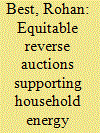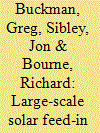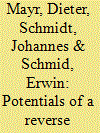|
|
|
Sort Order |
|
|
|
Items / Page
|
|
|
|
|
|
|
| Srl | Item |
| 1 |
ID:
190602


|
|
|
|
|
| Summary/Abstract |
A major challenge faced by policymakers has been determining appropriate subsidy amounts for household energy investments. This can result in inequitable support being either insufficient or excessive. Equitable reverse auctions offer a novel approach to address these issues. Households can bid an amount as a subsidy from the government that they require to go ahead with an energy investment. The lowest bids are successful in a reverse auction, allowing for cost-effective government support. The novel part is the pursuit of equity, as these auctions can occur separately for a pre-determined number of carefully chosen socio-economic groups. Equitable reverse auctions would lower inequality by design, relative to a common benchmark of equal subsidies, for a given government budget and environmental outcomes. Compared to a standard reverse auction, an equitable reverse auction will have greater equality by design but lower cost-effectiveness. However, the design of equitable reverse auctions is cost-effective within each socio-economic group. Non-additional subsidy spending would be reduced through reverse auctions. Equitable reverse auctions would be flexible to fit circumstances across countries, time, and technologies.
|
|
|
|
|
|
|
|
|
|
|
|
|
|
|
|
| 2 |
ID:
132593


|
|
|
|
|
| Publication |
2014.
|
| Summary/Abstract |
Feed-in tariffs (FiTs) offer renewable energy developers significant investor certainty but sometimes at the cost of being misaligned with generation costs. Reverse FiT auctions, where the FiT rights for a predetermined capacity are auctioned, can overcome this problem but can be plagued by non-delivery risks, particularly of competitively priced proposals. In 2012 and 2013 the Australian Capital Territory (ACT) Government in Australia conducted a FiT reverse auction for 40 MW of large-scale solar generating capacity, the first such auction undertaken in the country. The auction was highly competitive in relation to price and demonstrating low delivery risks. Proposal capital costs, particularly engineering, procurement and construction costs, as well as internal rates of return, were lower than expected. The auction process revealed limited land availability for large-scale solar developments in the ACT as well as a significant perceived sovereign risk issue. The auction process was designed to mitigate non-delivery risk by requiring proposals to be pre-qualified on the basis of delivery risk, before considering FiT pricing. The scheme is likely to be used by the ACT Government to support further large-scale renewable energy development as part of its greenhouse gas reduction strategy which is underpinned by a 90-per cent-by-2020 renewable energy target.
|
|
|
|
|
|
|
|
|
|
|
|
|
|
|
|
| 3 |
ID:
132689


|
|
|
|
|
| Publication |
2014.
|
| Summary/Abstract |
Photovoltaic (PV) has developed to one of the most promising technologies for renewable electricity generation. The Austrian government currently provides subsidies for roof-top PV systems through a constant, administratively determined feed-in tariff or an investment co-funding. In both subsidy schemes, applications are approved on a first-come, first-served basis. There are concerns about (i) the selection of suitable roofs for PV systems, and (ii) allocating subsidies among applicants to deploy roof-top PV systems cost-effectively. Thus we analyze the potentials of a simple discriminative first-price reverse auction application scheme. Applicants define individually the required level of subsidy and those with the lowest request for subsidies are selected. In an ex-post analysis, we evaluate the potentials of such a scheme in increasing power output and saving public spending for the federal state of Vorarlberg in Austria. Results indicate a potential increase of cumulated produced electricity between 15% and 18% in comparison to the current policy. In addition, a reverse auction-based system would lead to savings of public spending per kWh between 20% and 41%.
|
|
|
|
|
|
|
|
|
|
|
|
|
|
|
|
|
|
|
|
|